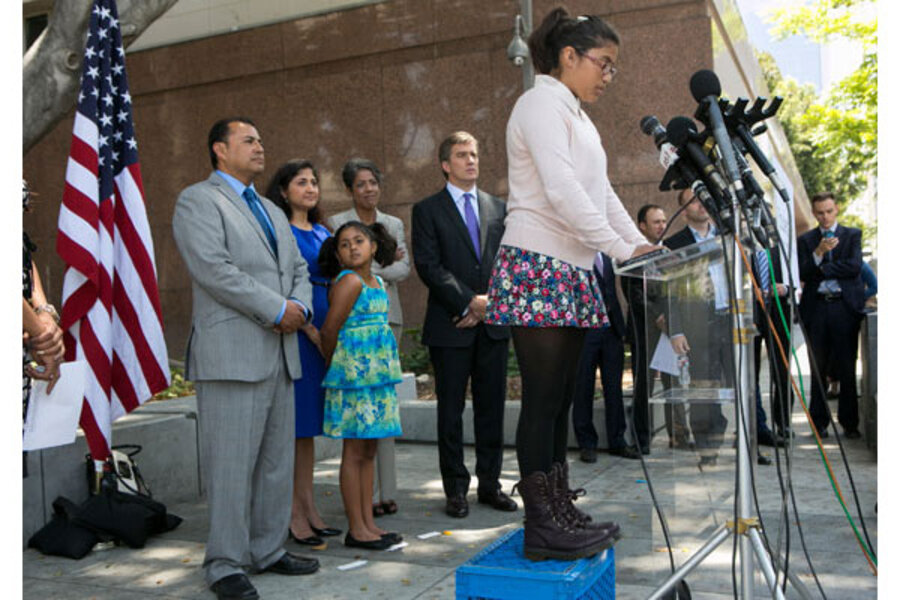California teacher tenure ruling: Not as earthshaking as it seems?
Loading...
| Los Angeles
Many educators are calling Tuesday's court decision – striking down five, key teacher protections as unconstitutional – a historic turning point that will vastly improve American education.
Teachers unions say the decision will result in a revolving door of teachers that will irreparably harm schools, and promise a years long legal fight.
In between, however, a number of experts suggest that the ruling is not as dire or as earthshaking as it is being portrayed. The ruling, which would strike down teacher tenure, for one, would give schools more flexibility in times of layoffs. But the deeper problem is not getting rid of bad teachers, but finding ways to recruit and support the best teachers, some say.
“Both sides are overstating the implications for the positive and the negative,” says Gary Painter, an education policy expert at the University of Southern California's Lusk Center for Real Estate in Los Angeles. “Getting rid of tenure doesn’t get rid of the other protections that teachers have.”
The lawsuit, Vergara v. California, was filed by students who claimed that they were being deprived of a good education. They said the state's teacher tenure system, which allows two years for evaluation before a teacher is hired permanently, does not provide sufficient time to weigh a teacher's effectiveness. Many students testified that they had horrible teachers that made them not want to attend class.
Getting rid of the law as it stands now will help, says Professor Painter. During the layoffs of the late 1990s, "a whole bunch of younger teachers, many whom Hispanics and African-Americans really liked, were let go, and older teachers, some who had lost their enthusiasm for the field, were brought in to replace them.”
Los Angeles Unified School District Superintendent John Deasy testified during the trial that it can take more than two years on average to fire an incompetent tenured teacher and sometimes as long as 10. The cost of doing so, he said, can run anywhere from $250,000 to $450,000.
But teachers unions suggest that that narrative is misleading. "Something else overlooked in all the claims about how hard it is to get rid of teachers: Most teachers who are asked to leave do so," says Fred Glass, a spokesman for the California Federation of Teachers. "So most of the time what the Vergara lawyers claim is a cumbersome process is avoided and the teacher is gone."
The teacher protections struck down in the Vergara ruling allow for a teacher to teach without "fear of losing his job" for something like using materials that some parents think are wrong, Mr. Glass says.
But some experts say the whole focus of the Vergara trial is misplaced. Firing bad teachers "is a very limited strategy for improving teaching," says James Stigler, a psychology professor at the University of California at Los Angeles and co-author of "The Teaching Gap."
“Teaching definitely needs to be improved, as anyone who spends time in classrooms could tell you,” he says. “The problem with firing teachers is that it doesn't tell us what, exactly, needs to be done to improve teaching overall. And, it begs the question: Who will you replace them with?”
His answer: "What we need to do is invest more in understanding the causes of variation in teaching, and then figuring out how to reduce variation while gradually improving quality."
Schools need to be places of innovation and excitement, and the Vergara lawsuit, despite its good intentions, doesn't address those needs, says Mark Naison, a professor of African-American studies at Fordham University in New York and co-founder of the Badass Teachers Association.
"Basically, this lawsuit symbolizes an approach to improving schools that can't work because it takes the creativity and freedom out of teaching. It assumes that the only way you can have good schools is to make them teacher-proof," he says. "No other society in the world is approaching things this way.”
“Unless we change course and ask our best teachers what we need to keep them, we will be treading water at best, and quite possibly making schools worse.”







